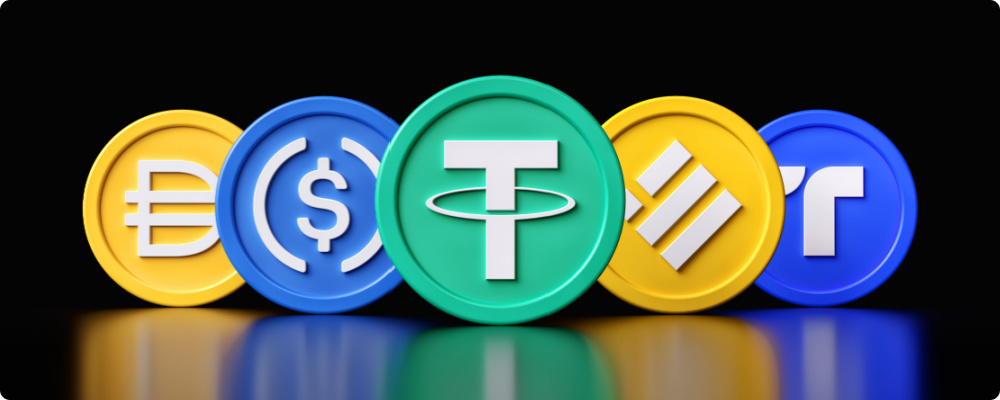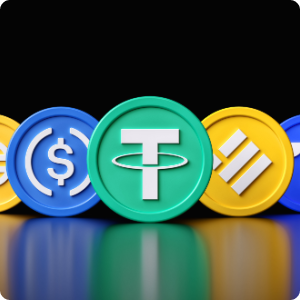

From Volatility to Stability: The Impact of Stablecoins in Web3
October 25th, 2023 | 5 minsIn the volatile world of cryptocurrencies, stablecoins stand out as a secure, predictable option amidst the inherent volatility of the ecosystem. This article explores how stablecoins are gaining traction in the Web3 ecosystem and how Meld's crypto stack is transforming the way developers integrate these stable assets.
Understanding Stablecoins
Stablecoins serve as a unique subset of cryptocurrencies, designed to offer stability by being anchored to traditional assets like the U.S. dollar or gold. They combine the best of both worlds: the quick transactions and robust security of cryptocurrencies, along with the stable value of fiat currencies.
So, why the buzz around stablecoins? The crypto market, while lucrative, is notoriously volatile. It offers high rewards but comes with equally high risks, making it less than ideal for everyday transactions or as a reliable store of value. This is where stablecoins come in. They offer a dependable medium for exchange, enabling users to transact and invest without the stress of sudden market fluctuations. In the dynamic and often unpredictable landscape of Web3, stablecoins act as a stabilizing force, providing a much-needed layer of security and predictability.
Offer your customers a wide range of stablecoins across 30+ chains and 40+ payment methods through Meld! Learn more here
Types of Stablecoins
1. Collateral-Backed Stablecoins
Collateral-backed stablecoins like Tether and USDC are the most prevalent, offering stability by being pegged to traditional assets such as the U.S. dollar.
2. Crypto-Collateralized and Algorithmic Stablecoins
While there are also crypto-collateralized and algorithmic stablecoins, they've faced challenges in maintaining stability. For example, TerraUSD, which used algorithms tied to Luna to determine its value, lost its stablecoin peg, leading to significant financial losses in the crypto space. Although not all crypto-collateralized and algorithmic stablecoins experience such volatility, potential investors should definitely do their due diligence before diving in.
Benefits of Stablecoins in the Fintech Ecosystem
Stablecoins are emerging as a transformative force in fintech offering a range of benefits including:
1. Price Stability and Reduced Volatility
Stablecoins offer a level of price stability that's often missing in the crypto world. This makes them an attractive option for people looking for a hedge against inflation, particularly in regions where the local currency is unstable. For the unbanked in countries experiencing hyperinflation, stablecoins pegged to the U.S. dollar can serve as a more reliable store of value, offering financial refuge.
2. Facilitating Cross-Border Transactions and Remittances
Stablecoins make cross-border transactions smoother and more cost-effective. In the remittance sector, they're a game-changer. For example, migrant workers can use stablecoins to send money back home quickly and affordably, bypassing the high fees and long wait times associated with traditional remittance services.
3. Enabling Decentralized Finance
Stablecoins are a cornerstone in the world of Decentralized Finance (DeFi). They serve as the stable asset in a variety of applications, from lending platforms to yield farming. For instance, in DeFi lending platforms, stablecoins can be used as collateral for loans, offering a more predictable value than volatile cryptocurrencies.
Benefits of Meld’s Crypto Stack
In emerging markets, Meld enhances financial accessibility by allowing users to purchase stablecoins with local payment methods. With support for over 30+ chains, users can choose from a diverse range of stablecoins, ensuring seamless access regardless of their blockchain preference. This is particularly valuable in areas where traditional financial avenues are limited, providing a secure and cost-effective method for stablecoin engagement. Through its comprehensive and user-centric solutions, Meld's Crypto Stack not only boosts the utility of stablecoins but also broadens access to financial stability and inclusion.
Learn more about how Meld is helping developers unlock crypto here
Conclusion
Stablecoins are rapidly becoming a cornerstone in the digital economy, offering a unique blend of stability, efficiency, and global accessibility. Their growing significance is evident in various sectors, from remittances to decentralized finance, acting as a stabilizing force in a volatile market.
Meld's Crypto Stack amplifies this impact by providing comprehensive stablecoin support across an impressive array of over 30 blockchain networks. Developers can empower their users to diversify their stablecoin holdings, engage in complex trading strategies effortlessly and more.
Meld is empowering developers to build a Multi Vendor Stack and launch faster than ever! Learn more about how to launch in weeks instead of sprints here.
FAQs
1. What is USDT and How Is It Different from USDC?
USDT (Tether) and USDC (USD Coin) are both collateral-backed stablecoins pegged to the U.S. dollar. While they serve similar purposes of providing stability in the volatile crypto market, they may differ in terms of regulatory compliance and transparency.
2. How Can I Buy USDC or USDT Through Meld's Crypto Stack?
Meld's Crypto Stack allows users to purchase stablecoins like USDC and USDT using local payment methods. This is especially valuable in emerging markets where traditional financial avenues are limited. The platform supports over 30+ blockchain networks, giving users a wide array of options for stablecoin engagement.
3. Why Are Stablecoins Important in the Fintech Ecosystem?
Stablecoins offer a level of price stability that's often missing in the crypto world. They are an attractive option for hedging against inflation and are crucial in facilitating cross-border transactions and remittances.
4. What Are the Different Types of Stablecoins?
Stablecoins can be categorized into collateral-backed, crypto-collateralized, and algorithmic stablecoins. Collateral-backed stablecoins like USDT and USDC are the most prevalent and are pegged to traditional assets like the U.S. dollar.


